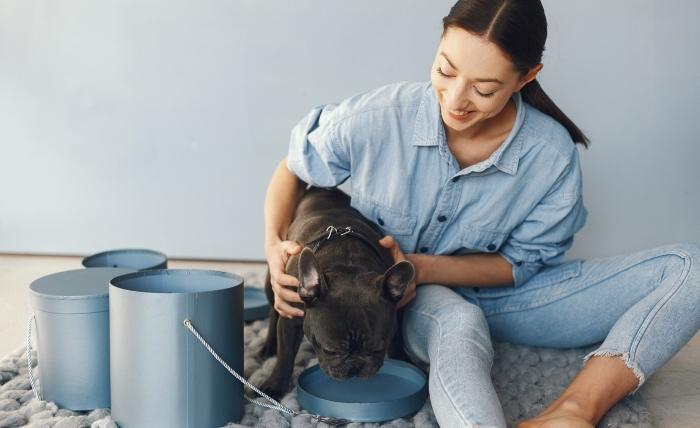Anxiety in dogs is a widespread issue that can significantly affect their quality of life and behavior. Whether it stems from separation, loud noises, or past trauma, helping your dog cope with anxiety is an essential part of being a responsible pet owner. With the right strategies and tools, you can alleviate your dog’s stress and create a more peaceful environment for them.
In this detailed guide, we’ll explore the causes and symptoms of dog anxiety and provide actionable methods to handle it, including the use of CBD for dogs as a natural remedy.
Understanding Dog Anxiety
What Causes Anxiety in Dogs?
Anxiety in dogs can arise from several factors, including:
- Separation Anxiety:
Dogs are highly social animals and may feel stressed or abandoned when left alone for long periods. - Noise Phobia:
Loud and sudden noises such as fireworks, thunderstorms, or vacuum cleaners are common triggers for anxiety. - New Environments and Situations:
Moving to a new home, traveling, or meeting unfamiliar people or animals can make your dog feel unsettled. - Past Trauma:
Rescue dogs or those with a history of abuse or neglect are more prone to anxiety due to their past experiences. - Aging and Health Issues:
Older dogs may experience anxiety due to cognitive decline or chronic pain from arthritis or other medical conditions.
Signs of Anxiety in Dogs
Recognizing anxiety in your dog is the first step toward helping them. Symptoms may vary but often include:
- Behavioral Signs: Excessive barking, whining, destructive chewing, or attempts to escape.
- Physical Signs: Pacing, panting, trembling, drooling, or hiding.
- Gastrointestinal Issues: Diarrhea, loss of appetite, or vomiting.
If you notice these signs regularly, it’s essential to address the underlying anxiety.
7 Ways to Handle Dog’s Anxiety
1. Create a Safe Space
Every dog needs a secure, quiet place where they feel protected during stressful situations.
- What to Include: Use their favorite blankets, toys, or calming pheromone sprays.
- Why It Helps: A safe space reduces external stimuli, offering your dog a chance to relax.
For example, during thunderstorms or fireworks, encourage your dog to retreat to their designated space to avoid overstimulation.
2. Regular Exercise and Mental Stimulation
Physical and mental activities are essential to channel your dog’s energy positively and reduce anxiety.
- Daily Walks: Regular walks help burn off excess energy and keep your dog calm.
- Playtime: Incorporate fetch, tug-of-war, or agility games to keep your dog active.
- Puzzle Toys: These stimulate their mind, keeping them engaged and distracted from stressors.
3. Behavior Training and Desensitization
Training can help your dog develop coping mechanisms for anxiety triggers. Two effective methods include:
- Desensitization: Gradually expose your dog to the source of their anxiety at a tolerable level. For instance, play recordings of thunder at a low volume and gradually increase it while offering treats.
- Counter-Conditioning: Replace their negative reaction with a positive one. For example, if your dog fears car rides, reward them with treats and praise each time they calmly enter the car.
Consistency and patience are key to successful training.
4. CBD for Dogs: A Natural Solution
CBD Oil for Dogs is a natural, non-psychoactive compound derived from hemp plants. It has gained popularity for its calming effects on dogs.
How CBD Helps with Anxiety:
- Regulates Stress Responses: CBD interacts with the endocannabinoid system, helping to stabilize mood and reduce stress.
- Eases Physical Symptoms: It alleviates symptoms like trembling, excessive panting, or pacing.
- Promotes Better Sleep: For dogs struggling with restlessness, CBD can help them relax and sleep better.
How to Administer CBD:
- Use CBD oils or treats specifically designed for pets.
- Start with a low dose (0.2 mg per pound of body weight) and gradually increase as needed.
- Administer CBD 30-60 minutes before anxiety-inducing events, such as car rides, vet visits, or loud noises.
Safety Tips:
- Ensure the product is THC-free and made for pets.
- Consult your vet before introducing CBD, especially if your dog is on medication.
5. Calming Aids and Toys
Products like calming vests, anxiety wraps, and chew toys infused with natural stress-relief ingredients can provide comfort.
- Anxiety Wraps: These apply gentle pressure to your dog’s torso, mimicking a comforting hug.
- Chew Toys: Some toys are infused with chamomile or valerian root, offering a calming effect during playtime.
6. Music and Aromatherapy
- Music Therapy: Play calming music to reduce external noise and soothe your dog. Research suggests that classical music works best for pets.
- Aromatherapy: Use pet-safe essential oils like lavender or chamomile in a diffuser to create a relaxing atmosphere. Always ensure the oils are non-toxic to pets.
7. Seek Professional Help When Needed
If your dog’s anxiety is severe or unmanageable with at-home methods, consult professionals:
- Veterinarian: They can rule out medical conditions and recommend appropriate medications or supplements.
- Certified Animal Behaviorist: For tailored behavioral training plans to address deep-seated anxiety issues.
When to See a Veterinarian
It’s crucial to seek professional guidance if your dog:
- Exhibits persistent anxiety symptoms despite intervention.
- Develops harmful behaviors, such as self-harm or aggression.
- Has underlying health issues that may contribute to their stress.
Conclusion
Managing anxiety in dogs requires patience, understanding, and a combination of strategies. From creating a safe space to incorporating natural remedies like CBD, there are many ways to help your furry friend feel more secure.
Remember, every dog is unique, so what works for one may not work for another. Always monitor your dog’s responses and adjust your approach accordingly. With consistency and care, you can create a stress-free environment where your dog can thrive.

